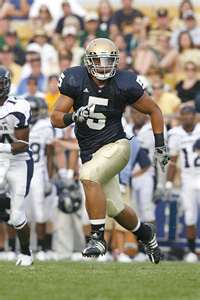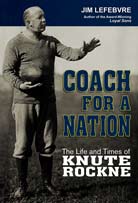The ten days from January 7 through 16, 2013, will go down as a period of unrelentingly shocking developments in the history of University of Notre Dame football.
And I think it’s not a stretch to say that the third in the series of shockers (the hoax surrounding the girlfriend of Manti Te’o) helps to explain the first (ND’s shellacking in the BCS Championship Game) and the second (Brian Kelly’s flirtation with the NFL).
It’s mind-boggling to imagine the hurt, shame, embarrassment, and confusion felt by Te’o in the days leading up to the national title game. From all indications, he had been duped into thinking he had a real relationship with a Lennay Kekua, and that she suffered injuries in a car accident, then was battling leukemia, before her “death” in September.
He appeared “lost” in the championship game. And as the undisputed leader of the Irish, it’s not difficult to imagine how his lack of energy and focus spread to teammates.
Those casting aspersions on Te’o and Notre Dame – that somehow they conspired to create this whole story in an effort to boost Manti’s bid for the Heisman Trophy – are so completely off-base as to look as ridiculous as anyone in this whole sordid mess. Before the season, and early into it, Notre Dame was an unranked team projected for 3-4 losses, and Te’o, as a defensive player, was as far from a Heisman candidate as you could imagine.
Yet, we’re supposed to believe that they cooked up a story of a dying girlfriend and milked it for publicity the rest of the season. If that’s the case, Te’o deserves not the Heisman, but an Oscar.
About Manti learning in early December that he had been duped, ND athletic director Jack Swarbrick said, “More than suspicious, he became startled, shocked…it goes to my comments about Manti and his character, but every single thing about this until that day in the first week of September was real to Manti. There was no suspicion that it wasn’t, no belief that it might not be. And so the pain was real. The grief was real. The affection was real. And that’s the nature of this sad, cruel game.”
No, the much more plausible explanation is exactly that given by Swarbrick (and supported by Manti’s statement). This was a hoax perpetrated on the ‘perfect mark’ – someone as open and trusting as you will ever find. Manti, teammates say, largely kept to himself and avoided any party scene at Notre Dame.
Sheltered by a tight family upbringing in Hawaii, devout to Mormonism and its various prohibitions, likely uncomfortable with relations with the opposite sex, and open, caring and trusting to all he met – yes, Manti would fit the profile of a ‘perfect mark.’
And as we find out more about Ronaiah Tuiasosopo, identified as the ring-leader of the hoax, a picture of a possible motive comes into view. Reports indicate he has run this scam before, and that it includes elements of “fund-raising” for a purported leukemia foundation. Manti and his expected millions from an NFL contract make an inviting target.
Coach Kelly has been largely silent in the whole Manti controversy, but one can surely see that, at least for a few days, seeking refuge in the football-only world of the NFL might have looked awfully appealing. But, as the so-called experts were calling the entire 2012 Notre Dame season a hoax, Kelly made the right decision: come back to campus determined to prove in 2013 that the Irish are indeed back, that this past season was no hoax, fluke or aberration.
Much of the Manti story should be focused on the state of journalism, if the word can even be used, in today’s America. As one who spent formative professional years in newsrooms of the 1970s, the stark contrast to today is shocking. Countless times in reading news stories which are confusing, poorly-written or downright inaccurate, I’ll cry out, “What kind of editor accepts this garbage without throwing it right back in the reporter’s face with a ton of questions?”
It’s a complete head-scratcher that no editor, upon hearing of Lennay Kekua’s “death”, dispatched reporters to southern California to find her family, learn about the funeral plans, get her back-story. With just a little effort, the whole hoax could have been exposed in mid-September.
In the past 48 hours alone, while we’ve seen numerous mea culpas from the news media on their role, we’ve also seen continued episodes of extremely questionable journalism.
Some of those who have opined on the Manti mess, especially a couple of Chicago columnists, have ignored the entirety of Swarbrick’s emotional news conference of Wednesday, and Manti’s statement, and blown right through to “of course they’re guilty” territory. Without a shred of credible evidence, they have convicted the player and the university.
I won’t dignify their insane rantings by naming them, but one has the audacity to write that, when given a choice between fiction or truth, Notre Dame always chooses fiction.
Oh, really? The 11 national championships, the 7 Heisman Trophy winners, some 200 All-Americans, regular rankings as the national leader in graduation rates. All fiction?
The thing of it is, Notre Dame didn’t need to create any myth around Manti Te’o. His play on the field, his leadership, his passion, spoke for themselves. And it was the national media, taking off on a few snippets reported locally in South Bend, that created whatever myths were presented.
Some have pounced on the references to Lennay in interviews Te’o gave on Dec. 8 and Dec. 10, after he learned of the hoax on Dec. 6, as “evidence” that he was perpetuating the ruse. But what 22-year-old, shocked and confused by the revelation that she didn’t exist, would have been able to sort out his feelings and the “facts” when questioned on a national stage?
More likely, one report notes, it was “quite possibly nothing more than a frightened and confused young man, unsure himself of what was going on or what to say.”
Might there have been some confusion along the way between Manti and his dad about how the two actually ‘met’? Was Manti embarrassed by the fact the relationship was strictly online and via phone? Did he say a few things to make it seem more ‘real’? Ask any parent of a 22-year-old whether they’re likely to get “the whole truth” when they ask that young person about their relationships. It’s not likely to happen.
Manti’s reactions and statements, indicating his confusion and embarrassment, are consistent with a victim of “catfishing,” the experts say.
And make no doubt, the victim here is Manti.








